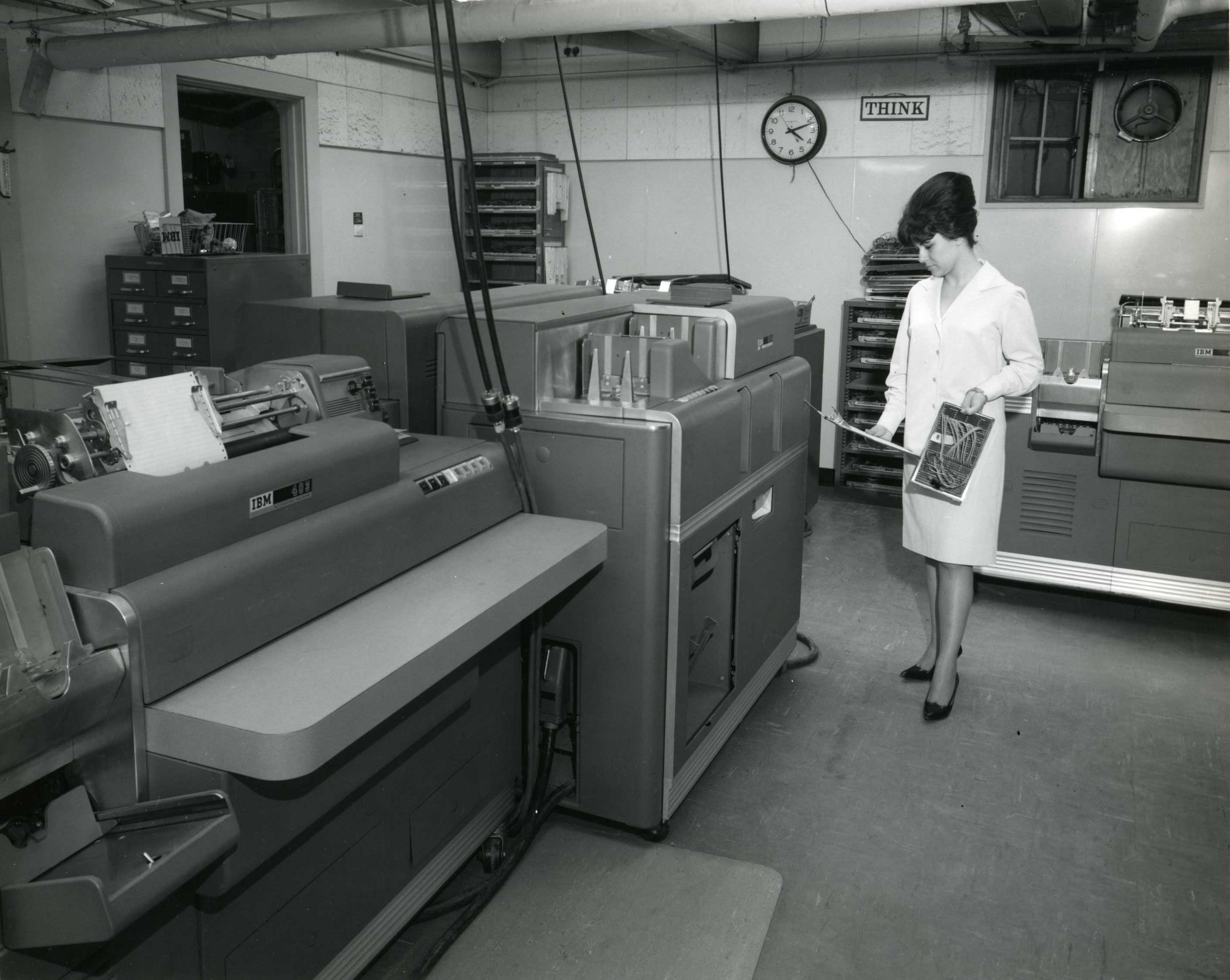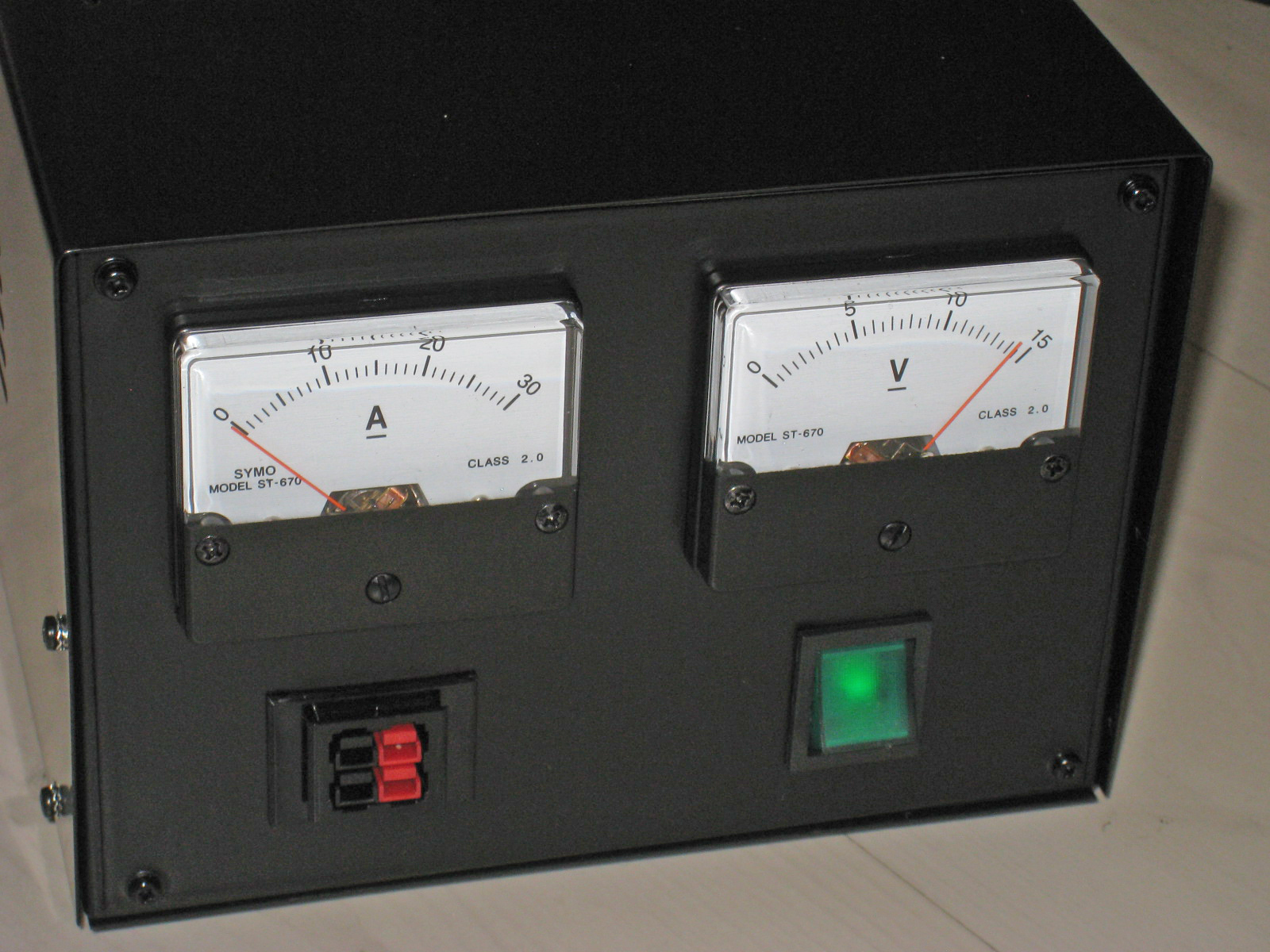|
IBM 514
The IBM 519 Document-Originating Machine, introduced in 1946, was the last in a series of unit record machines designed for automated preparation of punched cards. Others in the series included the IBM 513 & IBM 514 Reproducing Punch. The 519, which was "state of the art for the time", could: * reproduce all or parts of the information on a set of cards * " gangpunch" - copy information from a master card into the following detail cards * print up to eight digits on the end of a card * compare two decks of cards * "summary punch" — create punch cards containing summary information provided by a connected accounting machine, such as totals from a group of processed cards * "mark sense" — detect marks made with an electrographic pencil in designated locations on a punched card and then punch holes corresponding to those marks into the card * number cards consecutively (an optional feature) The reproducing, gangpunching, summary punching, and comparing features of the IBM 519 ar ... [...More Info...] [...Related Items...] OR: [Wikipedia] [Google] [Baidu] |
Unit Record Equipment
Starting at the end of the nineteenth century, well before the advent of electronic computers, data processing was performed using electromechanical machines collectively referred to as unit record equipment, electric accounting machines (EAM) or tabulating machines. Unit record machines came to be as ubiquitous in industry and government in the first two-thirds of the twentieth century as computers became in the last third. They allowed large volume, sophisticated data-processing tasks to be accomplished before electronic computers were invented and while they were still in their infancy. This data processing was accomplished by processing punched cards through various unit record machines in a carefully choreographed progression. This progression, or flow, from machine to machine was often planned and documented with detailed flowcharts that used standardized symbols for documents and the various machine functions. All but the earliest machines had high-speed mechanical feeders ... [...More Info...] [...Related Items...] OR: [Wikipedia] [Google] [Baidu] |
Watt
The watt (symbol: W) is the unit of power or radiant flux in the International System of Units (SI), equal to 1 joule per second or 1 kg⋅m2⋅s−3. It is used to quantify the rate of energy transfer. The watt is named after James Watt (1736–1819), an 18th-century Scottish inventor, mechanical engineer, and chemist who improved the Newcomen engine with his own steam engine in 1776. Watt's invention was fundamental for the Industrial Revolution. Overview When an object's velocity is held constant at one metre per second against a constant opposing force of one newton, the rate at which work is done is one watt. : \mathrm In terms of electromagnetism, one watt is the rate at which electrical work is performed when a current of one ampere (A) flows across an electrical potential difference of one volt (V), meaning the watt is equivalent to the volt-ampere (the latter unit, however, is used for a different quantity from the real power of an electrical circuit ... [...More Info...] [...Related Items...] OR: [Wikipedia] [Google] [Baidu] |
Herman Hollerith
Herman Hollerith (February 29, 1860 – November 17, 1929) was a German-American statistician, inventor, and businessman who developed an electromechanical tabulating machine for punched cards to assist in summarizing information and, later, in accounting. His invention of the punched card tabulating machine, patented in 1884, marks the beginning of the era of mechanized binary code and semiautomatic data processing systems, and his concept dominated that landscape for nearly a century. Hollerith founded a company that was amalgamated in 1911 with several other companies to form the Computing-Tabulating-Recording Company. In 1924, the company was renamed "International Business Machines" ( IBM) and became one of the largest and most successful companies of the 20th century. Hollerith is regarded as one of the seminal figures in the development of data processing. Personal life Herman Hollerith was the son of German immigrant Georg Hollerith, a school teacher from Großfischling ... [...More Info...] [...Related Items...] OR: [Wikipedia] [Google] [Baidu] |
The Washington Post
''The Washington Post'' (also known as the ''Post'' and, informally, ''WaPo'') is an American daily newspaper published in Washington, D.C. It is the most widely circulated newspaper within the Washington metropolitan area and has a large national audience. Daily broadsheet editions are printed for D.C., Maryland, and Virginia. The ''Post'' was founded in 1877. In its early years, it went through several owners and struggled both financially and editorially. Financier Eugene Meyer purchased it out of bankruptcy in 1933 and revived its health and reputation, work continued by his successors Katharine and Phil Graham (Meyer's daughter and son-in-law), who bought out several rival publications. The ''Post'' 1971 printing of the Pentagon Papers helped spur opposition to the Vietnam War. Subsequently, in the best-known episode in the newspaper's history, reporters Bob Woodward and Carl Bernstein led the American press's investigation into what became known as the Waterga ... [...More Info...] [...Related Items...] OR: [Wikipedia] [Google] [Baidu] |
Milan, Italy
Milan ( , , Lombard: ; it, Milano ) is a city in northern Italy, capital of Lombardy, and the second-most populous city proper in Italy after Rome. The city proper has a population of about 1.4 million, while its metropolitan city has 3.26 million inhabitants. Its continuously built-up urban area (whose outer suburbs extend well beyond the boundaries of the administrative metropolitan city and even stretch into the nearby country of Switzerland) is the fourth largest in the EU with 5.27 million inhabitants. According to national sources, the population within the wider Milan metropolitan area (also known as Greater Milan), is estimated between 8.2 million and 12.5 million making it by far the largest metropolitan area in Italy and one of the largest in the EU.* * * * Milan is considered a leading alpha global city, with strengths in the fields of art, chemicals, commerce, design, education, entertainment, fashion, finance, healthcare, ... [...More Info...] [...Related Items...] OR: [Wikipedia] [Google] [Baidu] |
IBM Rochester
IBM Rochester is the facility of IBM in Rochester, Minnesota. The initial structure was designed by Eero Saarinen, who clad the structure in blue panels of varying hues after being inspired by the Minnesota sky, as well as IBM's nickname of " Big Blue". These features and the facility's size has earned it the nickname "The Big Blue Zoo" from employees. History Early years Groundbreaking for the facility took place on July 31, 1956. When it was first completed, there was 576,000 square feet (53,500 m2) of floor space. There is 3.1 million square feet (290,000 m2) today on the main campus, more than half the size of the Pentagon in Arlington, Virginia. Rumors have appeared over the years suggesting that the structure was designed to look like a punched card from above, but this is more due to the facility's expansion over the years rather than an intention by Saarinen. The building was first dedicated in 1958, but has been expanded considerably since then. Current deve ... [...More Info...] [...Related Items...] OR: [Wikipedia] [Google] [Baidu] |
Power Supply
A power supply is an electrical device that supplies electric power to an electrical load. The main purpose of a power supply is to convert electric current from a source to the correct voltage, current, and frequency to power the load. As a result, power supplies are sometimes referred to as electric power converters. Some power supplies are separate standalone pieces of equipment, while others are built into the load appliances that they power. Examples of the latter include power supplies found in desktop computers and consumer electronics devices. Other functions that power supplies may perform include limiting the current drawn by the load to safe levels, shutting off the current in the event of an electrical fault, power conditioning to prevent electronic noise or voltage surges on the input from reaching the load, power-factor correction, and storing energy so it can continue to power the load in the event of a temporary interruption in the source power ( uninterr ... [...More Info...] [...Related Items...] OR: [Wikipedia] [Google] [Baidu] |
Hot Swapping
Hot swapping is the replacement or addition of components to a computer system without stopping, shutting down, or rebooting the system; hot plugging describes the addition of components only. Components which have such functionality are said to be ''hot-swappable'' or ''hot-pluggable''; likewise, components which do not are ''cold-swappable'' or ''cold-pluggable''. Most desktop computer hardware, such as CPUs and memory, are only cold-pluggable. However, it is common for mid to high-end servers and mainframes to feature hot-swappable capability for hardware components, such as CPU, memory, PCIe, SATA and SAS drives. An example of hot swapping is the express ability to pull a Universal Serial Bus (USB) peripheral device, such as a thumb drive, external hard disk drive (HDD), mouse, keyboard, or printer out of a computer's USB slot or peripheral hub without ejecting it first. Most smartphones and tablets with tray-loading holders can interchange SIM cards without powe ... [...More Info...] [...Related Items...] OR: [Wikipedia] [Google] [Baidu] |
Plugboard
A plugboard or control panel (the term used depends on the application area) is an array of jacks or sockets (often called hubs) into which patch cords can be inserted to complete an electrical circuit. Control panels are sometimes used to direct the operation of unit record equipment, cipher machines, and early computers. Unit record equipment Main article: Unit record equipment The earliest machines were hardwired for specific applications. Control panels were introduced in 1906 for the Hollerith Type 1 Tabulatorphoto of Type 3 with built-in control panel here. Removable control panels were introduced with the Hollerith ( IBM) type 3-S tabulator in the 1920s. Applications then could be wired on separate control panels, and inserted into tabulators as needed. Removable control panels came to be used in all unit record machines where the machines use for different applications required rewiring. IBM removable control panels ranged in size from 6 1/4" by 10 3/4" (for ... [...More Info...] [...Related Items...] OR: [Wikipedia] [Google] [Baidu] |
SIGABA
In the history of cryptography, the ECM Mark II was a cipher machine used by the United States for message encryption from World War II until the 1950s. The machine was also known as the SIGABA or Converter M-134 by the Army, or CSP-888/889 by the Navy, and a modified Navy version was termed the CSP-2900. Like many machines of the era it used an electromechanical system of rotors to encipher messages, but with a number of security improvements over previous designs. No successful cryptanalysis of the machine during its service lifetime is publicly known. History It was clear to US cryptographers well before World War II that the single-stepping mechanical motion of rotor machines (e.g. the Hebern machine) could be exploited by attackers. In the case of the famous Enigma machine, these attacks were supposed to be upset by moving the rotors to random locations at the start of each new message. This, however, proved not to be secure enough, and German Enigma messages were freque ... [...More Info...] [...Related Items...] OR: [Wikipedia] [Google] [Baidu] |







_4.jpg)